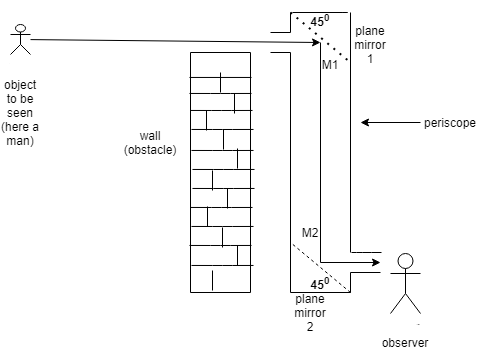
The image formed in a periscope is :
A) Real with lateral inversion.
B) Virtual with lateral inversion.
C) Real without lateral inversion.
D) Virtual without lateral inversion.
Answer
576.3k+ views
Hint: A periscope is an optical instrument that uses a system of prisms, lenses, or mirrors to reflect images. A mirror is placed at a specific angle near the eye of an observer and another on another end of the periscope which sends the light of the object to the eye of the observer. The object exists in essence but not in actuality and it shows the image in virtual and the lateral inversion by two mirrors cancel each other.
Complete step by step answer:
A periscope is defined as an instrument used for observing over, around or through an obstacle or object which is prevented by direct line of sight. It consists of an outer case with the mirrors fitted at ${45^0}$ angle. These mirrors are placed parallel to the surface.
Before getting anything about the question it is important to know about the workings of a periscope. For better understanding there is a figure below:

Here, in the picture, a person is there below who wished to see another person behind the wall. He saw him with the help of the periscope.
Working of periscope:
From the diagram, we can clearly state that the image is virtual and the mirror placed parallel to each other at ${45^0}$ angle makes it laterally inverted two times. When a ray gets reflected by M1 (mirror 1) it gets shifted incident ray for M2(mirror 2) and results in a virtual image without lateral inversion. The image formed in a periscope is virtual without lateral inversion because 2 lateral inversions cancel each other.
$\therefore $The image formed in a periscope is virtual without lateral inversion. Hence option D is correct.
Note:
Uses of a periscope:
- In the military periscopes are used to observe from their hiding positions.
- Periscopes are widely used in ships and submarines to determine the distance of a torpedo or another ship and helps in deciding the right time to attack or rescue operations.
- Used in a nuclear reactor to observe the chemical reactions that are taking place inside.
Complete step by step answer:
A periscope is defined as an instrument used for observing over, around or through an obstacle or object which is prevented by direct line of sight. It consists of an outer case with the mirrors fitted at ${45^0}$ angle. These mirrors are placed parallel to the surface.
Before getting anything about the question it is important to know about the workings of a periscope. For better understanding there is a figure below:

Here, in the picture, a person is there below who wished to see another person behind the wall. He saw him with the help of the periscope.
Working of periscope:
From the diagram, we can clearly state that the image is virtual and the mirror placed parallel to each other at ${45^0}$ angle makes it laterally inverted two times. When a ray gets reflected by M1 (mirror 1) it gets shifted incident ray for M2(mirror 2) and results in a virtual image without lateral inversion. The image formed in a periscope is virtual without lateral inversion because 2 lateral inversions cancel each other.
$\therefore $The image formed in a periscope is virtual without lateral inversion. Hence option D is correct.
Note:
Uses of a periscope:
- In the military periscopes are used to observe from their hiding positions.
- Periscopes are widely used in ships and submarines to determine the distance of a torpedo or another ship and helps in deciding the right time to attack or rescue operations.
- Used in a nuclear reactor to observe the chemical reactions that are taking place inside.
Recently Updated Pages
A man running at a speed 5 ms is viewed in the side class 12 physics CBSE

State and explain Hardy Weinbergs Principle class 12 biology CBSE

Which of the following statements is wrong a Amnion class 12 biology CBSE

Two Planoconcave lenses 1 and 2 of glass of refractive class 12 physics CBSE

The compound 2 methyl 2 butene on reaction with NaIO4 class 12 chemistry CBSE

Bacterial cell wall is made up of A Cellulose B Hemicellulose class 12 biology CBSE

Trending doubts
What are the major means of transport Explain each class 12 social science CBSE

Which are the Top 10 Largest Countries of the World?

Draw a labelled sketch of the human eye class 12 physics CBSE

Explain sex determination in humans with line diag class 12 biology CBSE

The pH of the pancreatic juice is A 64 B 86 C 120 D class 12 biology CBSE

Give 10 examples of unisexual and bisexual flowers




